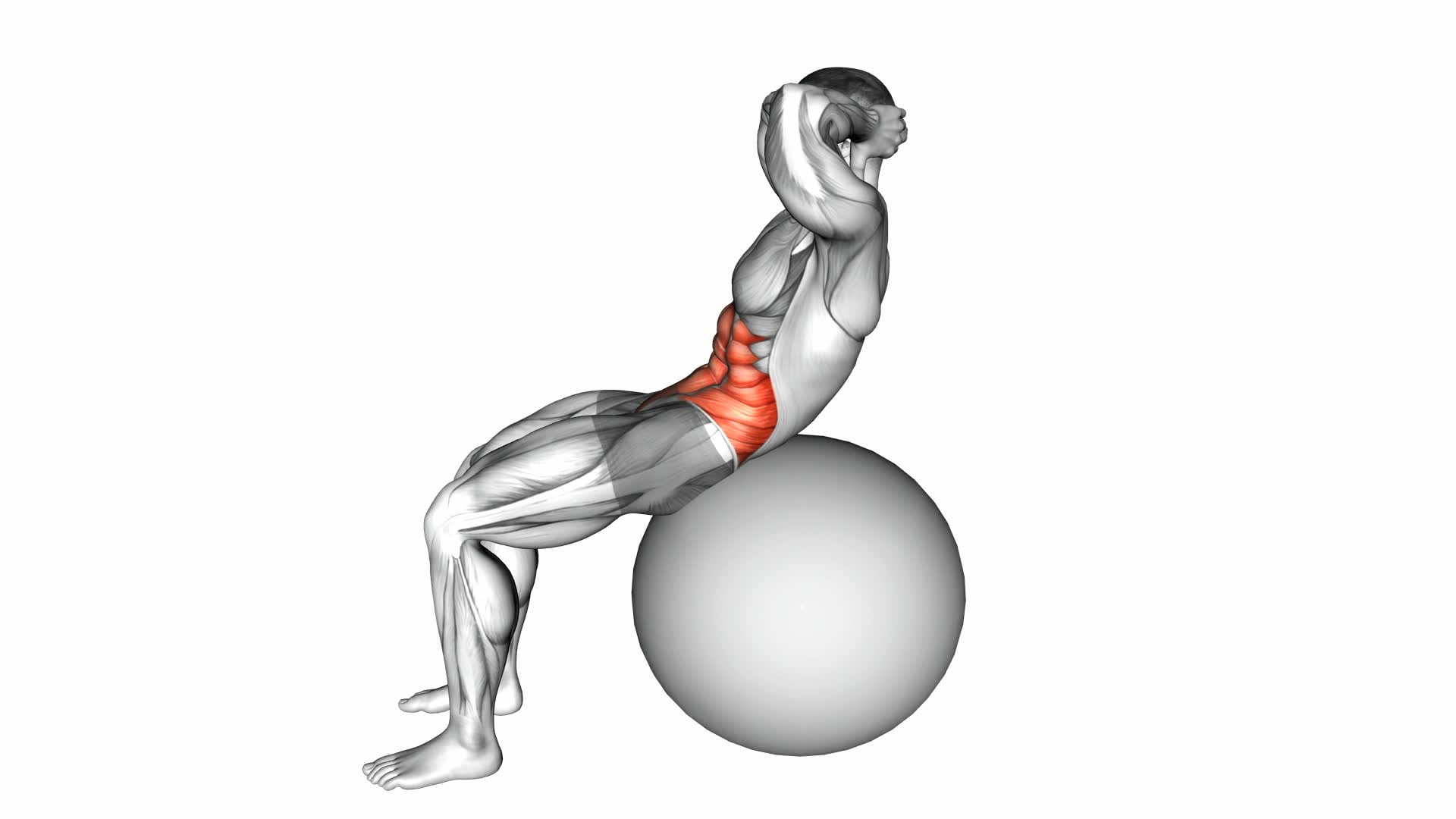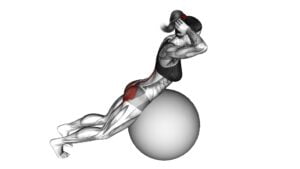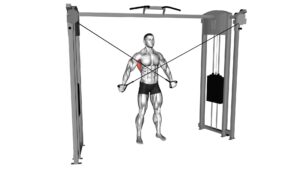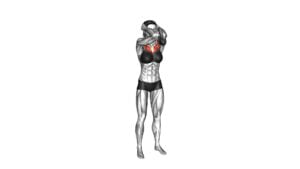Stability Ball Crunch (Full Range Hands Behind Head) – Video Exercise Guide & Tips

Get ready to strengthen your core with the stability ball crunch! In this exercise, you'll be lying on a stability ball with your hands behind your head.
Watch This Exercise Video
This full range movement will target your abdominal muscles and help improve stability. With just a stability ball and a few minutes of your time, you can work towards a stronger core.
Follow along with our video exercise guide and discover helpful tips to maximize your results.
Let's get started!
Key Takeaways
- Stability Ball Crunch strengthens core muscles and improves stability and balance.
- It targets multiple muscle groups and enhances posture and spinal alignment.
- The exercise can be modified to suit different fitness levels.
- Proper form and technique, as well as gradual progression, are important for safety and effectiveness.
Benefits of Stability Ball Crunch
Get ready to reap the benefits of the Stability Ball Crunch! This exercise is highly effective for strengthening your core muscles and improving your overall stability. By using a stability ball, you create an unstable surface that requires your core muscles to work harder to maintain balance and stability. This increased activation of your core muscles results in a more intense and efficient workout.
One of the key benefits of the Stability Ball Crunch is that it targets multiple muscle groups at once. Not only does it work your abdominal muscles, but it also engages your back muscles, hip flexors, and obliques. This comprehensive approach ensures that you're getting a full-body workout and maximizing your results.
Another advantage of the Stability Ball Crunch is that it allows for a greater range of motion compared to traditional crunches. With your hands behind your head, you can fully extend your torso, engaging a larger portion of your abdominal muscles. This increased range of motion helps to strengthen your core muscles more effectively.
In conclusion, the Stability Ball Crunch offers a range of benefits and is highly effective in targeting your core muscles. Its ability to engage multiple muscle groups and provide a greater range of motion makes it an excellent exercise choice.
Now, let's move on to the equipment needed for the Stability Ball Crunch.
Equipment Needed for Stability Ball Crunch
To perform the Stability Ball Crunch, you'll need a stability ball. Stability ball exercises are great for core strengthening and can help improve your overall stability and balance. The stability ball, also known as a Swiss ball or exercise ball, is a large inflatable ball made of durable material. It's designed to support your body weight and provide an unstable surface for your exercises.
When choosing a stability ball, make sure it's the right size for your height. Most stability balls come in different sizes, so refer to the manufacturer's guidelines to determine the appropriate size for you. The general rule is that when seated on the ball, your knees should be at a 90-degree angle and your feet should be flat on the floor.
In addition to the stability ball, you may also need a mat or a soft surface to lie on. This will provide cushioning and support for your back during the exercise. Once you have the necessary equipment, you can proceed to learn the proper form and technique for stability ball crunch.
Now that you have the stability ball and other equipment ready, let's move on to the next section and learn how to perform the stability ball crunch with proper form and technique.
Proper Form and Technique for Stability Ball Crunch
Now let's delve into the proper form and technique for performing the stability ball crunch, building upon the information discussed in the previous subtopic. To ensure you're executing this exercise correctly, follow these steps:
- Start by sitting on the stability ball with your feet flat on the floor, shoulder-width apart.
- Slowly walk your feet forward as you lean back, allowing the ball to roll under your lower back. Make sure your back is fully supported by the ball.
- Place your hands behind your head, interlocking your fingers, and keep your elbows wide open.
- Engage your core muscles and lift your upper body off the ball, curling your torso towards your thighs.
- Exhale as you crunch up and inhale as you return to the starting position.
- Make sure to keep your neck relaxed and avoid pulling on your head with your hands.
- Maintain a controlled and smooth movement throughout the exercise, avoiding any jerking or swinging motions.
- Aim to perform the stability ball crunch with proper form and technique, rather than rushing through the repetitions.
- Remember to breathe consistently and maintain proper alignment throughout the exercise.
Variations and Modifications for Stability Ball Crunch
For added challenge and variety, you can try different variations and modifications of the stability ball crunch. These variations target different muscle groups and intensify the workout.
One variation is the stability ball oblique crunch, where you twist your torso to the side while performing the crunch to engage the oblique muscles.
Another variation is the stability ball reverse crunch, where you lift your hips off the ball and bring your knees towards your chest, targeting the lower abdominal muscles.
If you want to make the exercise more challenging, you can add weights by holding a dumbbell or medicine ball against your chest. This increases the resistance and works your abdominal muscles even harder.
Additionally, you can modify the stability ball crunch by placing the ball against a wall to provide stability and support. This modification is helpful for beginners or those with balance issues.
Remember to always maintain proper form and listen to your body. Start with the variations and modifications that suit your fitness level and gradually progress as you become stronger and more comfortable with the exercise.
Tips for Getting the Most Out of Your Stability Ball Crunch
To maximize the effectiveness of your stability ball crunch, focus on proper form and engage your core muscles throughout the exercise. Here are some tips to help you get the most out of your stability ball crunch:
- Keep your feet flat on the ground and your knees bent at a 90-degree angle. This will provide a stable base for your crunches.
- Place your hands behind your head with your fingertips lightly touching your temples. This will help support your neck and prevent strain.
- As you crunch up, exhale and contract your abdominal muscles. This will help you generate more power and intensity in your crunches.
- Avoid pulling on your neck or using momentum to lift yourself up. Instead, focus on using your abdominal muscles to initiate the movement.
- Maintain a slow and controlled pace throughout the exercise. This will ensure that you're targeting your abs effectively and avoiding any potential injuries.
- Common mistakes to avoid include arching your back and relying too much on your arms to lift yourself up. Keep your back flat against the stability ball and let your abs do the work.
- Remember to breathe steadily throughout the exercise. Inhale as you lower yourself back down and exhale as you crunch up.
Frequently Asked Questions
How Many Repetitions Should I Do for Stability Ball Crunches?
To maximize the benefits of stability ball crunches, it's important to determine the right number of repetitions. By doing so, you can effectively target your core muscles and improve strength and stability.
Start with a moderate number of repetitions, such as 10-15, and gradually increase as you get stronger.
Remember to maintain proper form and engage your abs throughout each repetition.
Consistency is key to seeing results and avoiding injury.
Can Stability Ball Crunches Help With Reducing Belly Fat?
Stability ball crunches are an effective exercise for reducing belly fat. By incorporating stability ball crunches into your workout routine, you can benefit from their ability to target and strengthen your abdominal muscles.
This exercise helps to increase muscle activation and burn calories, which can contribute to fat loss. Remember to maintain proper form and engage your core throughout the movement for optimal results.
Incorporating stability ball crunches into your fitness routine can help you achieve your goals.
What Muscles Does the Stability Ball Crunch Target?
When doing stability ball crunches, you target multiple muscles in your core. The main ones are your rectus abdominis, which give you those defined abs, and your obliques, which help with twisting movements. These exercises also engage your hip flexors and lower back muscles.
To get the most out of stability ball crunches, make sure to maintain proper form and technique. Keep your hands behind your head, engage your core, and lift your upper body off the ball using your abs.
Is It Necessary to Use a Stability Ball for Crunches, or Can I Do Them on the Floor?
Yes, it's necessary to use a stability ball for crunches. Using a stability ball adds extra benefits to your crunches.
It helps to engage your core muscles more effectively and improves your balance and stability.
If you don't have a stability ball, you can try alternative exercises such as floor crunches or reverse crunches.
However, using a stability ball is highly recommended for optimal results and added challenge to your workout.
Can Stability Ball Crunches Help Improve Posture?
Stability ball crunches can definitely improve your posture. By engaging your core muscles and promoting stability, these crunches help strengthen the muscles that support proper posture.
To get the most out of this exercise, make sure to maintain proper form and technique. Keep your hands behind your head, and focus on using your abdominal muscles to lift your upper body off the stability ball.
Remember to exhale as you crunch up and inhale as you lower back down.
Conclusion
To maximize the benefits of stability ball crunches, use proper form and technique. Keep your hands behind your head, engage your core, and perform the exercise in a controlled manner. Remember to breathe throughout and avoid straining your neck or back.
By incorporating variations and modifications, you can challenge your muscles in different ways. Practice these tips to make the most out of your stability ball crunches and achieve stronger abdominal muscles.

Author
Years ago, the spark of my life’s passion ignited in my mind the moment I stepped into the local gym for the first time. The inaugural bead of perspiration, the initial endeavor, the very first surge of endorphins, and a sense of pride that washed over me post-workout marked the beginning of my deep-seated interest in strength sports, fitness, and sports nutrition. This very curiosity blossomed rapidly into a profound fascination, propelling me to earn a Master’s degree in Physical Education from the Academy of Physical Education in Krakow, followed by a Sports Manager diploma from the Jagiellonian University. My journey of growth led me to gain more specialized qualifications, such as being a certified personal trainer with a focus on sports dietetics, a lifeguard, and an instructor for wellness and corrective gymnastics. Theoretical knowledge paired seamlessly with practical experience, reinforcing my belief that the transformation of individuals under my guidance was also a reflection of my personal growth. This belief holds true even today. Each day, I strive to push the boundaries and explore new realms. These realms gently elevate me to greater heights. The unique combination of passion for my field and the continuous quest for growth fuels my drive to break new ground.







